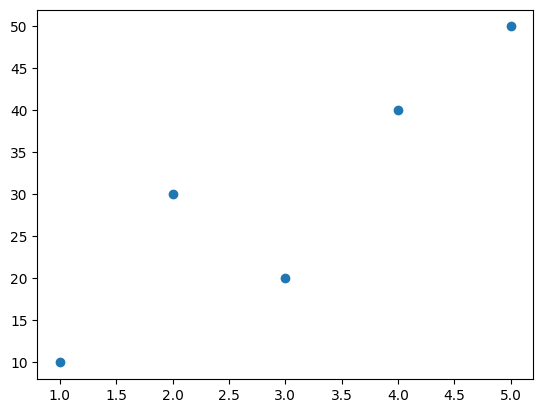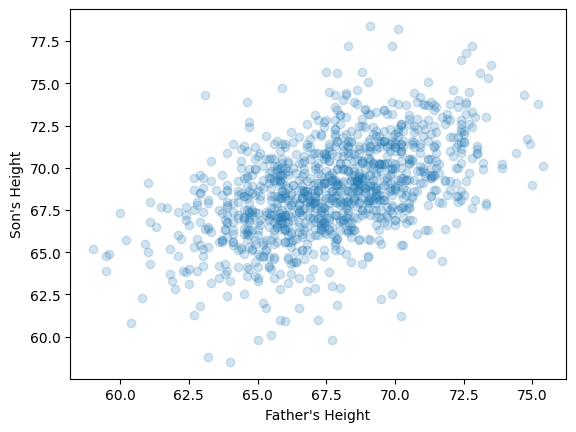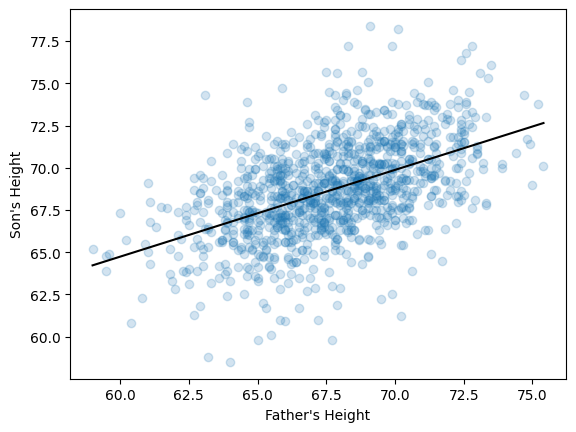Regression#
This is a series of basic examples for running linear regression with StatWrap. It’s more typical to use a package like sklearn or statsmodels for regression, but StatWrap is written to imitate Google Sheets/Excel.
Beyond StatWrap, there are two well known libraries for running regressions in Python, StatsModels and Scikit-Learn. Use StatWrap if you want to keep things simple. Use Scikit-Learn if you are interested in machine learning applications. Use StatsModels if you are focused on pure stats (eg statistical inference) or want something closer to R. It’s a more natural choice for this course than scikit-learn.
StatWrap#
Imports#
Run the typical three starter lines in a Google Colab (suggested) or Jupyter notebook.
!pip install --upgrade statwrap
import statwrap
%use_all
Example 1#
x = 1, 2, 3, 4, 5
y = 10, 30, 20, 40, 50
scatter_plot(x,y)
print('Correlation:', correl(x,y))

Correlation: 0.8999999999999999
# Direct Estimation
regression_line = linest(y, x)
regression_line
# predict y for x = 1 and x = 2
regression_line(1), regression_line(2)
(np.float64(11.999999999999986), np.float64(20.999999999999986))
# Use correlation
correlation = correl(x,y)
sd_x = sd(x)
sd_y = sd(y)
slope = correlation * sd_y/sd_x
# y_average = intercept + slope*x_average
intercept = average(y) - slope*average(x)
print(f'predicted Y = {intercept} + {slope}*X')
predicted Y = 3.0 + 9.0*X
Example 2 - Read from CSV#
Now we use a package called pandas to import data. Pandas does not have to be explicitly imported because of the %use_all command we used earlier. Later, we use a package called matplotlib to plot a regression line. Again, matplotlib doesn’t have to be explicitly imported.
url = 'https://raw.githubusercontent.com/alexanderthclark/Stats1101/main/Data/FatherSonHeights/pearson.csv'
# load a DataFrame
df = pd.read_csv(url)
# inspect first five rows
df.head()
| Father | Son | |
|---|---|---|
| 0 | 65.0 | 59.8 |
| 1 | 63.3 | 63.2 |
| 2 | 65.0 | 63.3 |
| 3 | 65.8 | 62.8 |
| 4 | 61.1 | 64.3 |
father = df.Father
son = df.Son
scatter_plot(father, son,
xlabel = "Father's Height",
ylabel = "Son's Height",
alpha = 0.2) # reduce opacity of points

reg_line = linest(son, father) # y then x
reg_line
scatter_plot(father, son,
xlabel = "Father's Height",
ylabel = "Son's Height",
alpha = 0.2, # reduce opacity of points
show = False) # tell Python to let us add more stuff to the plot
# Add regression line using matplotlib
x_range = father.min(), father.max()
y_predictions = reg_line(x_range)
plt.plot(x_range, y_predictions, color = 'black')
plt.show()

StatsModels#
import statsmodels.api as sm
# data
x = (1,2,3,4,5)
y = (1,4,3,4,10)
# Add a constant to the model (intercept)
X = sm.add_constant(x)
# Fit the model
model = sm.OLS(y, X).fit()
#model.summary()
# coefficients for intercept, slope
model.params
array([-1. , 1.8])
residuals_sm = model.resid
StatsModels for R Users#
import statsmodels.formula.api as smf
import pandas as pd
data = pd.DataFrame({"x": x, "y": y})
model_smf = smf.ols(formula='y ~ x', data=data).fit()
residuals_smf = model_smf.resid
#model_smf.summary()
# coefficients for intercept, slope
model_smf.params
Intercept -1.0
x 1.8
dtype: float64
Scikit Learn#
from sklearn.linear_model import LinearRegression
import numpy as np
# Create a linear regression model
model_sk = LinearRegression()
# convert x and y to arrays
x_sk = np.array(x).reshape(-1,1)
y_sk = np.array(y)
# Run the regression
# note the order of x and y is different
model_sk.fit(x_sk, y_sk)
# Get the coefficients
print(f"Slope: {model_sk.coef_}")
print(f"Intercept: {model_sk.intercept_}")
Slope: [1.8]
Intercept: -0.9999999999999991
# Predictions
y_pred = model_sk.predict(x_sk)
# Calculate residuals
residuals_sk = y_sk - y_pred

